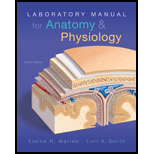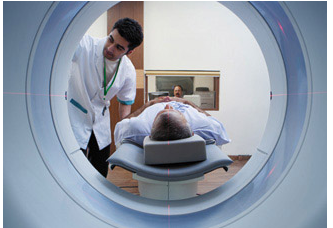
Mr. Heyden, a somewhat stocky 72-year-old man, is brought in to the emergency room (ER). The paramedics report that his left arm and the left side of his body trunk were pinned beneath some wreckage in a bus accident, and that when he was freed, his left hypogastric and lumbar areas appeared to be compressed and his left arm was blanched and without sensation. On admission, Mr. Heyden is alert, slightly cyanotic, and complaining of pain in his left side; he loses consciousness shortly thereafter. His vital signs are taken, blood is drawn for laboratory tests, and Mr. Heyden is catheterized and immediately scheduled for a CT scan of his left abdominal region.

Analyze the information that was subsequently recorded on Mr. Heyden’s chart:
Urinalysis: Some granular casts (particulate cell debris) are noted, and the urine is brownish-red in color; other values are normal, but urine output is very low. An order is given to force fluids.
(a) What might account for the low volume of urine output? (Name at least two possibilities.) (b) What might explain the casts and abnormal color of his urine? Can you see any possible relationship between his crush injury and these findings?
The next day, Mr. Heyden is awake and alert. He says that he now has feeling in his arm, but he still complains of pain. However, the pain site appears to have moved from the left upper quadrant to his lumbar region. His urine output is still low. He is scheduled once again for a CT scan, this time of his lumbar region. The order to force fluids is renewed and some additional and more specific blood tests are ordered. We will visit Mr. Heyden again shortly, but in the meantime think Think about what these new findings may indicate.
Want to see the full answer?
Check out a sample textbook solution
Chapter 25 Solutions
Laboratory Manual for Anatomy & Physiology (6th Edition) (Anatomy and Physiology)
- (b) Explain why the colloid osmotic pressure of the plasma is much higher than the colloid osmotic pressure of interstitial fluid and why this is important in ensuring excess tissue fluid does not accumulate to cause edema.arrow_forwardNote in part (a) that the normal resting value on this pressure–frequency curve is on the steepest, center part of the curve. What is the physiological significance of this?arrow_forwardA 4-year-old child was admitted to the clinic with signs of prolonged protein starvation: growth and mental retardation, anemia, and edema. What caused the development of edema in the child?arrow_forward
- Jennifer R. has the “stomach flu” that is going around campus and has been vomiting profusely for the past 24 hours. Not only has she been unable to keep down fluids or food, but she has also lost the acidic digestive juices secreted by the stomach that are normally reabsorbed back into the blood farther down the digestive tract. What body systems respond to resist these changes (exlcuding nervous and endocrine systems)? Provide three.arrow_forwardDefine carbaminohemoglobinarrow_forwardCan the transport through the capillaries in the right foot be affected by an edema? Explain.arrow_forward
- 1) Identify the lab value of Marcelo's arterial carbon dioxide levels in mmHg. Only type in numbers, no letters. Type out your answer to zero places after the decimal point (i.e 23) pH = 7.55 HCO3- = 60 mEq 2) Marcelo's condition is determined to be: 3 answers required: respiratory or metabolic acidosis or alkalosis uncompensated or partial compensation Group of answer choices respiratory metabolic acidosis alkalosis uncompensated partial compensationarrow_forwardAn injured soccer player arrives by ambulance in the emergency room. She is in obvious distress, breathing rapidly. Her blood PCO2 is 26 mm Hg and pH is 7.5. Is she suffering from hyperventilation or hyperpnea? Explain.arrow_forwardFor each of the following, state whether it might result in dehydration, hypotonic hydration, or edema (discussed in Chapter 18): (a) decreased synthesis of plasma proteins due to liver failure; (b) copious sweating; (c) using ecstasy (MDMA), which promotes ADH secretion.arrow_forward
- Given the Starling forces that can promote movement, list three organs that need to be evaluated because of their ability to promote such edema and why.arrow_forwardExplain why orthostatic (postural) hypotension may occurwith vasodilator drugs.arrow_forwardIf a patient has had their spinal nerve cord severed just below C-7, could the patient still ventilate? Why?arrow_forward
 Anatomy & PhysiologyBiologyISBN:9781938168130Author:Kelly A. Young, James A. Wise, Peter DeSaix, Dean H. Kruse, Brandon Poe, Eddie Johnson, Jody E. Johnson, Oksana Korol, J. Gordon Betts, Mark WomblePublisher:OpenStax College
Anatomy & PhysiologyBiologyISBN:9781938168130Author:Kelly A. Young, James A. Wise, Peter DeSaix, Dean H. Kruse, Brandon Poe, Eddie Johnson, Jody E. Johnson, Oksana Korol, J. Gordon Betts, Mark WomblePublisher:OpenStax College Human Physiology: From Cells to Systems (MindTap ...BiologyISBN:9781285866932Author:Lauralee SherwoodPublisher:Cengage Learning
Human Physiology: From Cells to Systems (MindTap ...BiologyISBN:9781285866932Author:Lauralee SherwoodPublisher:Cengage Learning


